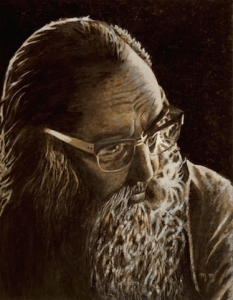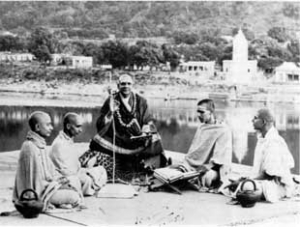
Swami Chinmayananda, portrait by Manisha Melwani
What is Vedanta?
Vedanta is not a religion but a spiritual science of life.
It has developed from the cumulative wisdom of generations of spiritual masters from the Himalayan regions of India.
“Just as physics, biology and other sciences are not the exclusive property of any one country, or people in a particular era or age, but are universally applicable, respective of time and age; similarly the science of living as pronounced by the rishis (spiritual masters) in Vedanta, visualizes a plan of life to suit all people, at all times, everywhere.”
– Swami Chinmayananda, Master of Vedanta (1916-1993)
The spiritual masters sought out the answers to the deeper questions of life by turning within in meditation.
In meditation, they became the instruments through which the Truth of life was revealed. They discovered the answers to questions such as:
- What is the cause of the world and where can it be found?
- What is its nature and what is my relationship with it?
- Who am I?
- Where have I come from and where will I go after death?
- What is the meaning and purpose of life?
Vedanta is based on the contemplative inner findings and personal reflections of these spiritual masters.

Swami Sivananda, great teacher of Vedanta, with his disciples by the banks of the Ganges River in Rishikesh, Northern India. – Divine Life Society, Rishikesh.
What is the origin of Vedanta?
The masters taught the knowledge that they had gained to their students. They then encouraged further discussions with them.
The students were expected to question the teacher and take on the task of finding the truth of what they had learned through their own independent reflection and meditation.
Dogma or blind belief had no place in the transferal of knowledge between the teachers and their students.
The students eventually went on to become masters in their own right, guiding others in their spiritual quest. Each master taught his students the knowledge that he had learned from his teacher and added the knowledge that was revealed to him in his own meditation. In this way, the body of knowledge grew over succeeding generations.
 In the very beginning, the teachers taught purely through word of mouth. This was because this teaching tradition predates the time when man learned to read and write.
In the very beginning, the teachers taught purely through word of mouth. This was because this teaching tradition predates the time when man learned to read and write.
At a later point in the history of man, these teachings were finally recorded and preserved in four great volumes of knowledge called the Vedas.
The four Vedas are the Rig, Veda Yajur Veda, Sama Veda and Atharva Veda.
The word Vedanta is made up of two words – Veda and anta. Veda comes from the Sanskrit word, vid, which means “to know,” and anta means “the end.”
The teachings of Vedanta are found at the end portion of each of the Vedas. In fact, ‘Vedanta’ literally means the ‘end of the Vedas’.
Figuratively, the ‘end’ of something is the goal for which it is sought for; it contains its essence.
So, Vedanta contains the knowledge that is essential to every human being—the knowledge of our true spiritual nature, the Self.
Once we realize our own infinite and blissful spiritual nature, there will be nothing more to know, accomplish, or have. It will bring us the consummation of all our desires and an absolute fulfilment in life. It will put a permanent end to all our sorrows and striving for happiness. The teachings of Vedanta are, therefore, wisdom for all humankind.









